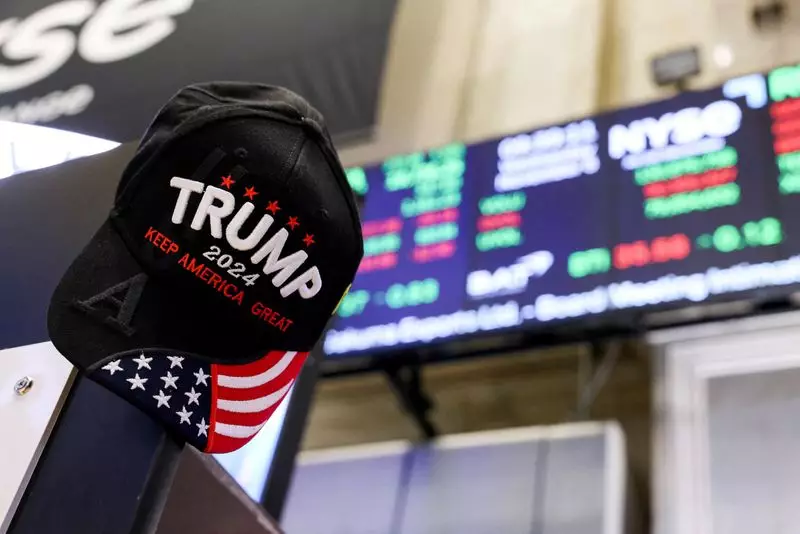The recent trading session on Wall Street marked a notable downturn, with the main indices closing lower as market participants processed a complex array of economic indicators and mixed earnings reports. Specifically, Friday’s market activity raised concerns about future trends as traders prepared to navigate an upcoming week rife with significant economic releases and a Federal Reserve meeting. Notably, the technology sector emerged as the leading dampener on the market, after major tech stocks, particularly Nvidia, experienced a reversal from an earlier rally.
The fluctuations in the housing sector bore additional weight on investor sentiments, where indicators hinted at a stronger-than-anticipated market. However, simultaneous figures from an S&P Global survey depicted a deceleration in business activity to its slowest pace in nine months, coinciding with a rise in prices. This dichotomy serves to illustrate the complexities of the current economic landscape, underscoring the challenges for policymakers and investors alike.
Consumer sentiment, a critical metric often linked to spending and economic vitality, fell with the University of Michigan’s final estimate dipping from 73.2 to 71.1. This downturn raises questions about consumer attitudes and the potential implications for economic growth moving forward. While these numbers alone may not dictate market direction, they contribute to a broader picture that investors must navigate as they pivot toward upcoming Federal Reserve decisions, particularly in light of anticipated inflation and growth data releases.
As traders brace for the Fed’s meeting later this month, the consensus appears to lean towards no changes in borrowing costs, prolonging the existing monetary policy that has characterized the economic climate. The latest data from CME Group’s FedWatch tool indicates a significant expectation for the first rate cut by June. Such projections reflect a delicate balancing act that the Fed must engage in as it weighs various economic indicators against the backdrop of potential trade policy complications.
Another layer of complexity influencing market dynamics is the evolving landscape regarding U.S. trade policy. President Trump’s recent remarks surrounding proposed tariffs on major trading partners have heightened investor unease, especially concerning their potential ramifications on inflation and monetary policy. Formal announcements regarding tariffs are expected on February 1, with more comprehensive strategies anticipated by April. Investors remain vigilant, attempting to decipher the implications of these policy decisions on both domestic and international fronts.
The specter of increased tariffs looms large, as analysts express concern that such moves could add pressures on already strained supply chains, affecting manufacturing costs and consumer prices. In this context, the market’s response reflects a broader apprehension about the durability of economic recovery and policy stability under the current administration.
While the broader indices experienced week-over-week gains, Friday’s session saw marked declines within the technology sector, particularly as shares of chipmaker Texas Instruments fell following an unexpectedly weak earnings forecast. Similarly, Nvidia, known for its artificial intelligence chip market leadership, experienced a decline of 3.1%, reflecting investor trepidation about the sustainability of tech stock valuations amidst mixed earnings reports.
This highlights a critical point of contention: while technology has played a predominant role in driving recovery and growth, recent volatility suggests that caution reigns supreme among investors. Companies that previously experienced robust rallies are now grappling with the market’s reassessment, leading to a realignment of valuations that could set the stage for continued fluctuations.
Despite the challenges faced on Friday, it is worth noting that six out of the eleven S&P 500 sectors concluded the trading day with gains, led particularly by communications services and utilities. Notably, NextEra Energy, a utility giant, saw its shares rise by approximately 5.2%, underlining the sector’s appeal in a time of market turbulence.
On the other hand, more traditional sectors such as consumer discretionary and industrials faced headwinds as companies like American Express and Boeing reported mixed earnings, which spurred declines in their stock prices. The overarching narrative of a market responding to earnings and economic data reinforces the importance of vigilance for investors amidst the shifting sands of market sentiment.
In sum, the convergence of mixed economic data, sector-specific volatility, and pending trade policy announcements creates a landscape of uncertainty for Wall Street. Investors are called to exercise caution as they sift through the complexities of evolving economic indicators and corporate earnings reports. The interdependence of these factors illustrates the intricate web of influences shaping market movements, emphasizing that clarity may only be attainable through careful observation and analysis in the weeks to come.

